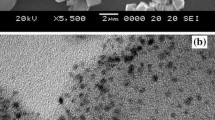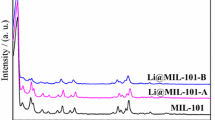Abstract
MIL-88A metal-organic framework with the unsaturated Fe metal coordination sites has demonstrated to be a promising material for gas storage and capture. However, the hydrogen storage capacity of MIL-88A has to be improved to meet the practical level at the ambient conditions. In this research, we elucidated the effects of transition metal substitution on the hydrogen storage capability of MIL-88A. The trivalent transition metals including Sc, Ti, V, Cr, Mn, and Ni have been selected to substitute for Fe in MIL-88A. Using the van der Waals dispersion-corrected density functional theory calculations, we explored the most favorable adsorption configurations of the hydrogen molecule in M-MIL-88A (M = Sc, Ti, V, Cr, Mn, Ni). We found that the V-MIL-88A has the strongest binding energy of 17 kJ mol−1 with the hydrogen molecule in the side-on configuration on the metal site. Besides, the grand canonical Monte Carlo simulations showed that the metal substitution greatly influences not only the favorable adsorption configuration and energy but also the hydrogen uptake due to the modification of the H2@MIL-88A interaction. Sc-MIL-88A was found to offer the highest gravimetric H2 uptake compared to the other M-MIL-88A. The value is 5.13 wt% at (cryogenic temperature 77 K, 50 bar) and 0.72 wt% at (room temperature 298 K, 100 bar) for the absolute; 4.63 wt% at (77 K, 10 bar) and 0.29 wt% at (298 K, 100 bar) for the excess capacity. Furthermore, Sc-MIL-88A also exhibited the highest volumetric uptake up to 52 g L−1 at 77 K and 7.1 g L−1 at 298 K for the absolute; 46 g L−1 at 77 K and 2.8 g L−1 at 298 K for the excess loading.









Similar content being viewed by others
References
Singh, A.K., Yakobson, B.I.: First principles calculations of H-storage in sorption materials. J. Mater. Sci. 47, 7356–7366 (2012). https://doi.org/10.1007/s10853-012-6551-7
K. Mazloomi, C. Gomes: Hydrogen as an energy carrier: prospects and challenges. Renew. Sustain. Energy Rev. 16, 3024–3033 (2012)
Nijem, N., Veyan, J.-F., Kong, L., et al.: Interaction of molecular hydrogen with microporous metal organic framework materials at room temperature. J. Am. Chem. Soc. 132, 1654–1664 (2010)
C. Liu, F. Li, L.P. Ma, H.M. Cheng: Advanced materials for energy storage. Adv. Mater. 22, E28–E62 (2010)
Niaz, S., Manzoor, T., Pandith, A.H.: Hydrogen storage: Materials, methods and perspectives. Renew. Sustain. Energy Rev. 50, 457–469 (2015)
Huang, A., He, Y., Zhou, Y., et al.: A review of recent applications of porous metals and metal oxide in energy storage, sensing and catalysis. J. Mater. Sci. 54, 949–973 (2018)
Xu, J., Liu, J., Li, Z., et al.: Synthesis, structure and properties of Pd@MOF-808. J. Mater. Sci. 54, 12911–12924 (2019)
Molefe, L.Y., Musyoka, N.M., Ren, J., et al.: Synthesis of porous polymer-based metal-organic frameworks monolithic hybrid composite for hydrogen storage application. J. Mater. Sci. 54, 7078–7086 (2019)
M.D. Allendorf, Z. Hulvey, T. Gennett, et al: An assessment of strategies for the development of solid-state adsorbents for vehicular hydrogen storage. Energy Environ. Sci 11, 2784–2812 (2018)
T.T.T. Huong, P.N. Thanh, N.T.X. Huynh, D.N. Son: Metal-organic frameworks: state-of-the-art material for gas capture and storage. VNU J. Sci. Math. Phys. 32, 67–85 (2016)
Czaja, A.U., Trukhan, N., Muller, U.: Industrial applications of metal–organic frameworks. Chem. Soc. Rev. 38, 1284–1293 (2009)
Furukawa, H., Ko, N., Go, Y.B., et al.: Ultrahigh porosity in metal-organic frameworks. Science 329, 424–428 (2010)
O.K. Farha, A. Yazaydın, I. Eryazici, et al: De novo synthesis of a metal-organic framework material featuring ultrahigh surface area and gas storage capacities. Nat. Chem. 2, 944–948 (2010)
Basdogan, Y., Keskin, S.: Simulation and modelling of MOFs for hydrogen storage. CrystEngComm. 17, 261–275 (2014). https://doi.org/10.1039/C4CE01711K
H.W. Langmi, J. Ren, B. North, et al: Metal-organic frameworks for hydrogen storage hydrogen storage in metal-organic frameworks: a review. Electrochim. Acta 128, 368–392 (2014)
J. Sculley, D. Yuan, H. Zhou: The current status of hydrogen storage in metal–organic frameworks-updated. Energy Environ. Sci. 4, 2721–2735 (2011)
Sumida, K., Hill, M.R., Horike, S., et al.: Synthesis and hydrogen storage properties of Be12(OH)12(1,3,5-benzenetribenzoate)4. J. Am. Chem. Soc. 131, 15120–15121 (2009)
M.T. Kapelewski, T. Runčevski, J.D. Tarver, et al: Record high hydrogen storage capacity in the metal-organic framework Ni2(m-dobdc) at near-ambient temperatures. Chem. Mater. 30, 8179–8189 (2018)
A. Ahmed, S. Seth, J. Purewal, et al: Exceptional hydrogen storage achieved by screening nearly half a million metal-organic frameworks. Nat. Commun. (2019). https://doi.org/10.1038/s41467-019-09365-w
Serre, C., Millange, F., Surblé, S., Férey, G.: A route to the synthesis of trivalent transition-metal porous carboxylates with trimeric secondary building units. Angew. Chem. Int. Ed. 43, 6286–6289 (2004)
C. Mellot-Draznieks, C. Serre, S. Surblé, et al: Very large swelling in hybrid frameworks: a combined computational and powder diffraction study. J. Am. Chem. Soc. 127, 16273–16278 (2005)
Xuan Huynh, N.T., Chihaia, V., Son, D.N.: (2018) Hydrogen storage in MIL-88 series. J. Mater. Sci. https://doi.org/10.1007/s10853-018-3140-4
N.T. Xuan Huynh, O.M. Na, V. Chihaia, D.N. Son: A computational approach towards understanding hydrogen gas adsorption in Co–MIL-88A. RSC Adv. 7, 39583–39593 (2017)
Rowsell, J.L.C., Yaghi, O.M.: Strategies for hydrogen storage in metal-organic frameworks. Angew. Chem. Int. Ed. 44, 4670–4679 (2005)
Vitillo, J.G., Regli, L., Chavan, S., et al.: Role of exposed metal sites in hydrogen storage in MOFs. J. Am. Chem. Soc. 130, 8386–8396 (2008)
Dion, M., Rydberg, H., Schröder, E., et al.: Van der Waals density functional for general geometries. Phys. Rev. Lett. 92, 246401 (2004)
T. Thonhauser, V.R. Cooper, S. Li, et al: Van der Waals density functional: self-consistent potential and the nature of the van der Waals bond. Phys. Rev. B 76, 125112(1-125112(12 (2007)
D.C. Langreth, B.I. Lundqvist, S.D. Chakarova-Käck, et al: A density functional for sparse matter. J. Phys. Condens. Matter 21, 084203 (2009)
Kresse, G., Furthmüller, J.: Efficient iterative schemes for ab initio total-energy calculations using a plane-wave basis set. Phys. Rev. B 54, 11169–11186 (1996)
Kresse, G., Furthmüller, J.: Efficiency of ab-initio total energy calculations for metals and semiconductors using a plane-wave basis set. Comput. Mater. Sci. 6, 15–50 (1996)
S. Zuluaga, P. Canepa, K. Tan, et al: Study of van der Waals bonding and interactions in metal organic framework materials. J. Phys. Condens. Matter 26, 133002 (2014). https://doi.org/10.1002/asia.201400031
D.N. Son, T.T.T. Huong, V. Chihaia: Simultaneous adsorption of SO2 and CO2 in an Ni(bdc)(ted)0.5 metal–organic framework. RSC Adv. 1, 38648–38655 (2018)
J. Perdew, J. Chevary, S. Vosko, et al: Atoms, molecules, solids, and surfaces: applications of the generalized gradient approximation for exchange and correlation. Phys. Rev. B 46, 6671–6687 (1992)
Perdew, J.P., Burke, K., Ernzerhof, M.: Generalized gradient approximation made simple. Phys. Rev. Lett. 77, 3865–3868 (1996)
Blochl, P.E.: Projector augmented-wave method. Phys. Rev. B 50, 17953–17979 (1994)
Kresse, G., Joubert, D.: From ultrasoft pseudopotentials to the projector augmented-wave method. Phys. Rev. B 59, 1758–1775 (1999)
Pack, J.D., Monkhorst, H.J.: Special points for Brillouin-zone integrations. Phys. Rev. B 13, 5188–5192 (1976)
Methfessel, M., Paxton, A.T.: High-precision sampling for Brillouin-zone integration in metals. Phys. Rev. B 40, 3616–3621 (1989)
Blochl, P.E., Jepsen, O., Andersen, O.K.: Improved tetrahedron method for Brillouin-zone integrations. Phys. Rev. B 49, 16223–16233 (1994)
Tyuterev, V.G., Vast, N.: Murnaghan’s equation of state for the electronic ground state energy. Comput. Mater. Sci. 38, 350–353 (2006)
Tang, W., Sanville, E., Henkelman, G.: A grid-based Bader analysis algorithm without lattice bias. J. Phys. Condens. Matter 21, 084204(7 (2009)
T.A. Manz, D.S. Sholl: Improved atoms-in-molecule charge partitioning functional for simultaneously reproducing the electrostatic potential and chemical states in periodic and nonperiodic materials. J. Chem. Theory Comput. 8, 2844–2867 (2012)
Dubbeldam, D., Calero, S., Ellis, D.E., Snurr, R.Q.: RASPA: molecular simulation software for adsorption and diffusion in flexible nanoporous materials. Mol. Simul. 42, 81–101 (2016)
Simulations, M.D.: (1992) UFF, a. 2:10024–10035
D. Levesque, A. Gicquel, F.L. Darkrim, S.B. Kayiran: Monte Carlo simulations of hydrogen storage in carbon nanotubes. J. Phys. Condens. Matter 14, 9285–9293 (2002)
Murnaghan, F.D.: Finite deformation of an elastic solid, 1st edn. Wiley, New York (1951)
A.L. da Rosa, S.M. Lee, E. Penev: The FHIMD toolkit—user’s manual. Fritz-Haber-Institut der Max-Planck-Gesellschaft, Berlin (2002)
Timokhin, I., White a, J.P., Lickiss, P.D., et al.: Microporous metal–organic frameworks built from rigid tetrahedral tetrakis(4-tetrazolylphenyl)silane connectors. CrystEngComm. 16, 8094–8097 (2014). https://doi.org/10.1039/c4ce00486h
M.V. Parkes, D.F. Sava Gallis, J.A. Greathouse, T.M. Nenoff: Effect of metal in M3(btc)2 and M2(dobdc) MOFs for O2/N2 separations: a combined density functional theory and experimental study. J. Phys. Chem. C 119, 6556–6567 (2015). https://doi.org/10.1021/jp511789g
Mowat, J.P.S., Seymour, V.R., Griffin, J.M., et al.: A novel structural form of MIL-53 observed for the scandium analogue and its response to temperature variation and CO2 adsorption. Dalt Trans. 41, 3937–3941 (2012). https://doi.org/10.1039/c1dt11729g
F. Millange, N. Guillou, R.I. Walton, et al: Effect of the nature of the metal on the breathing steps in MOFs with dynamic frameworks. Chem. Commun. (2008). https://doi.org/10.1039/b809419e
R.D. Shannon: Revised effective ionic radii and systematic studies of interatomic distances in halides and chalcogenides. Acta Cryst. A32, 751–767 (1976)
K. Lee, J.D. Howe, L.C. Lin, et al: Small-molecule adsorption in open-site metal-organic frameworks: a systematic density functional theory study for rational design. Chem. Mater. 27, 668–678 (2015)
A. Mavrandonakis, D. Vogiatzis, K. Boese, et al: Ab initio study of the adsorption of small molecules on metal-organic frameworks with oxo-centered trimetallic building units: the role of the undercoordinated metal ion. Inorg. Chem. 54, 8251–8263 (2015)
M.P. Suh, H.J. Park, T.K. Prasad, D.W. Lim: Hydrogen storage in metal—organic frameworks. Chem. Rev. 112, 782–835 (2012)
Siegel, D., Hardy, B.: HSECoE Team. (2015) Engineering an adsorbent-based hydrogen storage system: What have we learned? https://www.energy.gov/sites/prod/files/2015/02/f19/fcto_h2_storage_summit_siegel.pdf. Accessed 14 Feb, 2020
P. García-Holley, B. Schweitzer, T. Islamoglu, et al: Benchmark study of hydrogen storage in metal-organic frameworks under temperature and pressure swing conditions. ACS Energy Lett. 3, 748–754 (2018)
Acknowledgments
This research was funded by the Vietnam National Foundation for Science and Technology Development (NAFOSTED) under Grant Number 103.01-2017.04. We acknowledge the usage of the computer time and software granted by the Institute of Physical Chemistry of Romanian Academy, Bucharest (HPC infrastructure developed under the projects Capacities 84 Cp/I of 15.09.2007 and INFRANANOCHEM 19/01.03.2009).
Author information
Authors and Affiliations
Corresponding author
Ethics declarations
Conflict of interest
All authors declare that they have no conflict of interest.
Additional information
Publisher's Note
Springer Nature remains neutral with regard to jurisdictional claims in published maps and institutional affiliations.
Rights and permissions
About this article
Cite this article
Huynh, N.T.X., Chihaia, V. & Son, D.N. Enhancing hydrogen storage by metal substitution in MIL-88A metal-organic framework. Adsorption 26, 509–519 (2020). https://doi.org/10.1007/s10450-020-00213-8
Received:
Revised:
Accepted:
Published:
Issue Date:
DOI: https://doi.org/10.1007/s10450-020-00213-8




